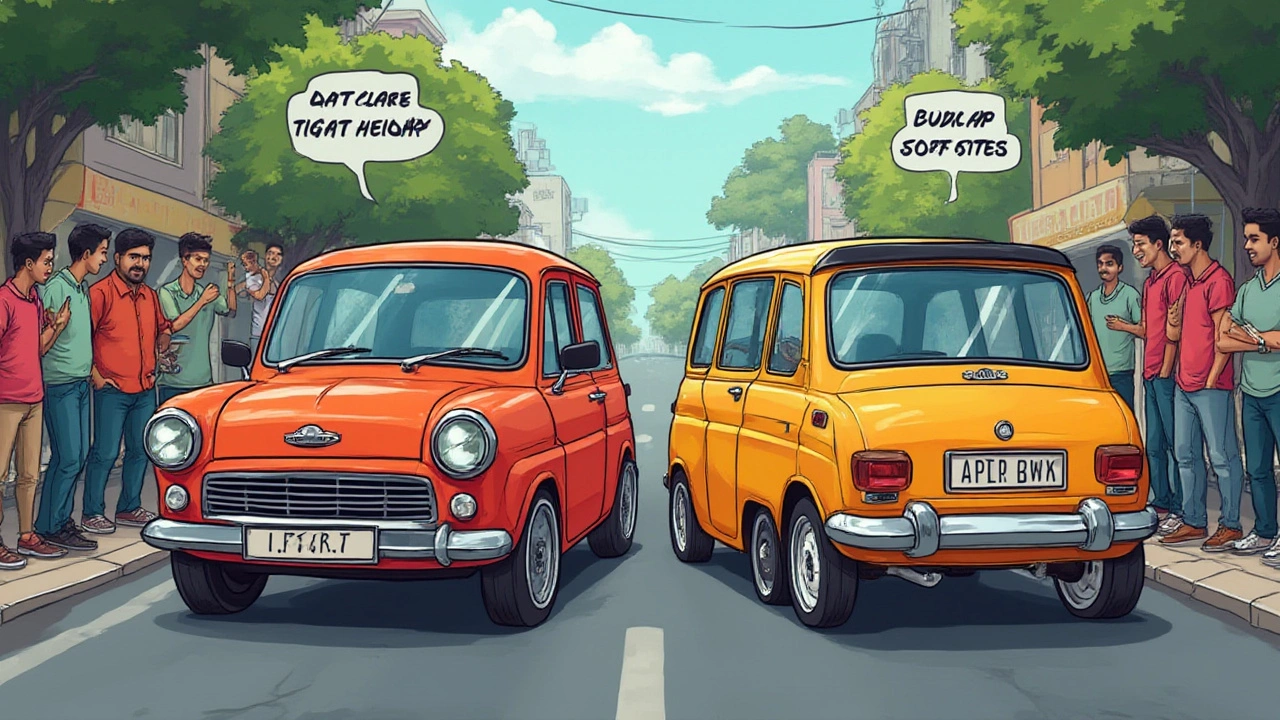Do You Need New Bump Stops When Installing Lowering Springs? Expert Advice Inside
 Jul, 21 2025
Jul, 21 2025
Changing the height of your car is always a bit of an adventure. Some mates do it for the looks, others chase sharper handling. Whatever your reason, lowering springs have a way of making any car look leaner and meaner right out of the gate. But after that box of bright new springs lands on your doorstep, you’ll probably wonder: do you actually need new bump stops to go with them? If you’ve ever heard an odd clunk after tackling a speed bump or wondered why your ride feels stiffer with lowering springs, you’re not alone. Bump stops (those little rubber blocks nobody really talks about) turn out to be more important than most folks think.
What Exactly Are Bump Stops and Why Do They Matter?
You’d be shocked at the number of car guys who’ve never even heard of bump stops, but trust me—they’re there, quietly doing their job behind the scenes. They sit on the strut rod or inside the shock, acting like a cushion to keep the suspension parts from crashing into each other. It might not sound exciting, but without them, every pothole could be a disaster for your shocks or even the chassis itself. Think of them as a last line of defense for your suspension, especially when you hit a nasty road imperfection faster than you meant to.
Originally, engineers pick the length and hardness of bump stops to suit your car’s factory suspension travel. Lowering springs, by design, cut down how far your suspension can move up and down. So, when you drop your ride, you’re getting closer to smashing those bump stops more often. A good example—on a stock VW Golf, the front bump stops are chunky, giving plenty of travel for daily driving. Swap on some lowering springs, suddenly the suspension bottoms out earlier. No surprise then, you’re relying on those bump stops far more than you ever did before.
And here’s a curveball—not all bump stops are built alike. Some are made from stiff polyurethane, others soft foam. They can be squared-off or have a cone-like shape. Their material and tech have a massive effect on how the car feels over rough roads. A 2021 test by Bilstein found that stiffer bump stops can cause harsher rebound while softer or progressive-rate stops tend to take the edge off. The point? They’re not just rubber blocks—they’re tuned parts designed for a specific job.
How Lowering Springs Change the Suspension Game
Let’s talk about what’s actually happening when you put in lowering springs. First, you drop the car’s centre of gravity, which does wonders for cornering but also shaves a chunk off available suspension travel. The stock shocks and springs have more wiggle room before hitting the bump stop. Drop the car 30mm, and you’re now working with a lot less space before you crash through to the stop. You might feel it in a stiffer ride or new, unexpected clunks—never a good soundtrack if you like your car in one piece.
This isn’t theoretical. Drop a BMW E46 by 35mm, and the factory bump stop starts being engaged much more frequently. If that stop is long and soft, you get a bouncy, uncontrolled rebound on rough roads. If it’s dense and short, every hard hit feels like the shock’s about to poke through the bonnet. That’s why car makers sometimes use dual-rate bump stops. They allow a cushioned initial contact, then firm up as you compress further. With aftermarket lowering springs, there’s a good chance your stock bump stops are now doing way more work than the original engineers expected.
Car makers have started to pay real attention to bump stop design the last decade or so. In some new sports cars—think of the latest Ford Focus ST—the bump stop is shaped to almost act as a mini secondary spring, helping refine the ride. When you change your springs, especially if you go for a brand not matched to your bump stops, you run the risk of upsetting all that balance.
Here’s a quick stat for reference. According to a study by KW Suspensions in 2022, up to 65% of failed aftermarket spring installs report ride issues due to not addressing the bump stops. That’s a massive hit rate, and it’s nothing to do with ‘bad springs’—it’s about not thinking through how all the parts interact. Most of those issues? Folks just reused the OE bump stops, not realising how much less travel they had to work with.

Do You Really Need New Bump Stops With Lowering Springs?
Now to the main question—do you truly need new bump stops if you throw on lowering springs? The answer isn’t a straight yes or no. For some cars, especially those not dropped much (say 15-20mm), you might squeak by with the stock setup. But if you’re going lower than that, or you want to protect your fresh shocks, swapping bump stops becomes more than just a ‘nice-to-have’—it’s insurance for ride quality and mechanical health.
Here’s why: if the bump stop is too long after lowering, you’ll bottom out more, leading to a harsh ride and possible damage. If it’s too short or missing, the suspension can over-compress, hitting metal-to-metal—never good for any suspension part. A lot of shock manufacturers (Bilstein, Koni, Eibach) sell shorter, firmer bump stops specifically for this reason. They’re not just selling rubber lumps—they’re accounting for the new suspension geometry and travel limits.
For real-world proof, check out owner forums for cars like the Mazda MX-5, Golf GTI, or BMW 3-Series. Threads are packed with examples from folks who ignored bump stops, only to end up with blown shocks, broken mounts, or bone-shaking rides. A simple swap or trim of stock bump stops could save a massive headache down the line.
| Drop Height | Recommended Bump Stop | Reason |
|---|---|---|
| 0-20mm | Stock/OEM | Minor loss of travel, original still suitable |
| 20-35mm | Trimmed OEM or Progressive | Reduced travel, trimming keeps some cushion |
| 35mm+ | Shorter Aftermarket/Performance | Substantial loss of travel, stiffer/firmer needed |
If you can’t find a ready-made kit for your car, many folks just carefully trim their stock bump stops. The idea is to preserve most of the progressive cushion while giving back a few centimeters of travel. Use a very sharp blade and go a little at a time—take off too much, and you’ve lost the safety net entirely. Some DIYers use bump stop kits sold by brands like SuperPro, or even hybrid setups (for example, using E46 M3 stops on a standard 3-Series). The goal? Maintain as much ride comfort and control, without blowing through your shortened travel on the first speed hump out of Tesco’s car park.
Here’s an interesting fact: lowering springs will almost always shorten the lifespan of your shocks if you don’t adapt your bump stops. It’s not urban legend, it’s basic mechanical physics. Every time the suspension bottoms out sharply, that impact isn’t absorbed gently anymore—something has to give. That ‘something’ is usually the shock internals. The cost of replacement bump stops (typically £20-£40 a pair) is peanuts compared to what new shocks cost if you get it wrong.
Practical Tips: Making Lowered Rides Comfortable and Safe
You don’t need a degree in engineering to get this right—but a little planning goes a long way. To keep things smooth and safe after installing lowering springs, here’s what you should check off your list:
- Check Your Travel: Measure the shock’s travel before and after lowering. Ideally you’ll have at least 20mm of compression before hitting the bump stop, even at rest with you in the driver’s seat.
- Inspect Old Stops: Old bump stops can crumble or harden after years of road gunk. If they’re cracked or brittle, just replace them—your future self will thank you.
- Match Suspension Parts: When ordering lowering springs, look for kits that come with pre-matched bump stops, or ones recommended by the spring manufacturer. Some combos are designed together, especially on newer platforms.
- Go Progressive if Possible: Progressive-rate bump stops are softer at first, then firm up—they’re a brilliant middle ground for daily driving on real-world roads full of potholes.
- Talk to Other Enthusiasts: Forums and local clubs are goldmines for what works on your car. Sometimes a slight mod, like switching to another spec bump stop from the same car family, does the trick.
- Test Before Final Assembly: After fitting, lower the car gently onto its wheels and push down firmly over each corner. Listen and feel for any odd noises or early contact with the stops. If it feels harsh straight away, reconsider your setup before taking a long drive.
If you’re running coilovers, things change slightly—most coilover kits come with matched bump stops, so you’re sorted. For spring-only swaps, though, bump stop choice is critical. Even high-end German tuners like H&R and Eibach design their kits around optimised bump stops. That’s how they keep their handling reputation intact.
Worth mentioning—if your car has adaptive dampers or electronic shocks (seen in newer BMWs, Audis, some Fords), always check for bump stop compatibility. These systems are touchy; mismatched stops can end up triggering errors or weird behaviour in the adaptive system.
A good ride isn’t just about slamming your car for TikTok aesthetics. The best setups strike a balance: lower stance, but still civilised enough for a trip down an unplanned country B road. Do it right, and your lowered car doesn’t just look better—it feels sharper to drive, keeps your wallet safer, and gives every journey that extra thrill without annoying clunks or cringy knocks every mile.
When you finally get it right, you’ll know it the first time your mate asks why your sporty hatchback still rides better than his half-done project. Pay attention to your bump stops. They’re the unsung heroes keeping your pride and joy riding like new.